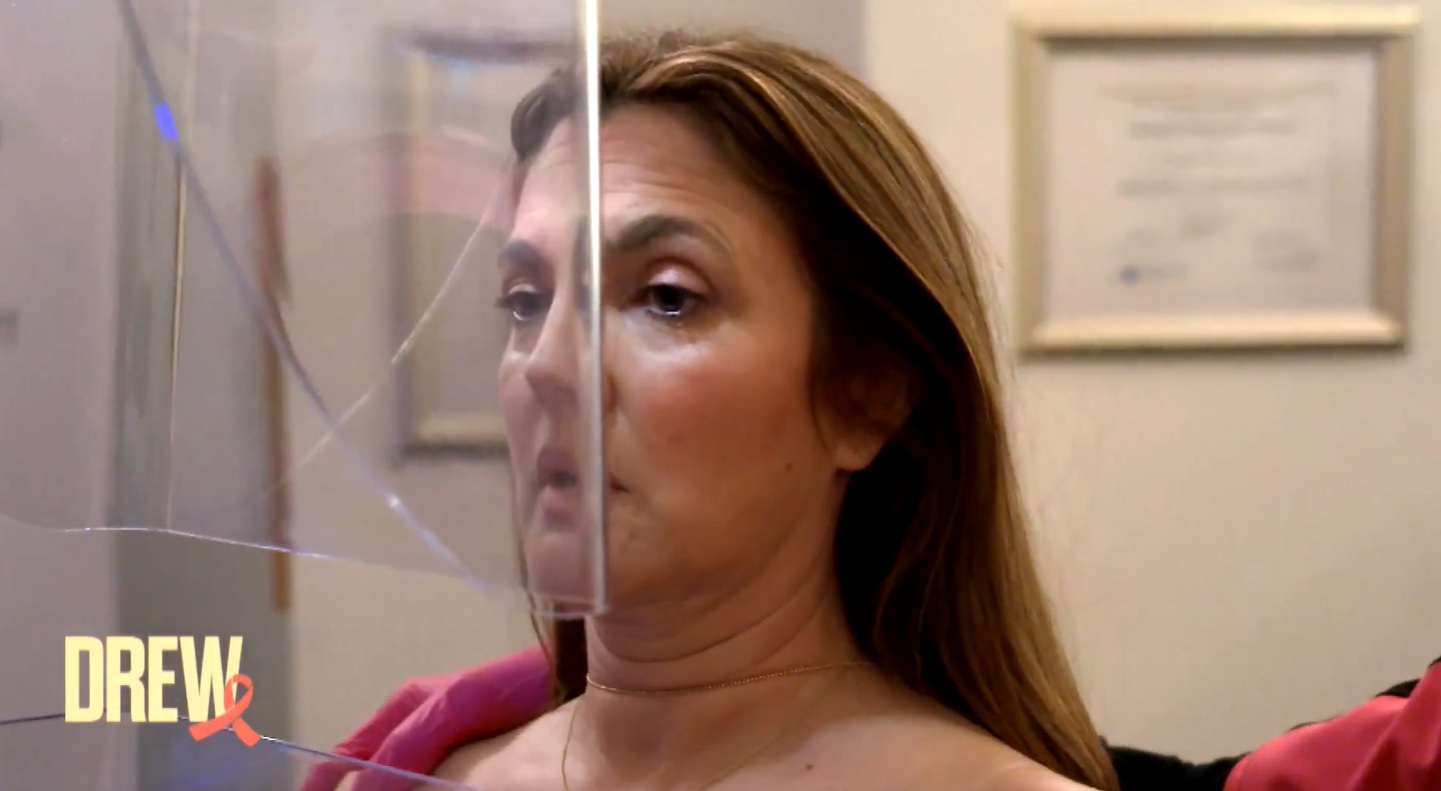Understanding What Goes Into Mammograms
- Actress Drew Barrymore, 48, helps ease anxieties surrounding mammograms by bringing her talk show viewers along for her breast cancer screening. She called her process “quick and painless” while emphasizing when to get screenings depends on your individual breast cancer risk.
- The U.S. Preventive Services Task Force recommends women at average breast cancer risk begin screening for breast cancer at age 40. Women with the BRCA gene mutation, who have a family history of cancer or have dense breasts, are at higher risk and should talk with their doctor about when to screen, and may be younger than 40.
- SurvivorNet experts recommend performing a monthly breast self-exam to look for anything unusual with your breasts because it can help catch breast cancer between regularly scheduled mammograms.
- Breast density is determined through mammograms. However, women with dense breasts are at a higher risk for developing breast cancer because dense breast tissue can mask potential cancer during screening.
- 3D mammograms, breast ultrasound, breast MRI, and molecular breast imaging are options for women with dense breasts for a more precise screening. It is important to ask your doctor about your breast density and cancer risk.
Actress Drew Barrymore, 48, brought viewers on her popular talk show along through her process of getting a mammogram. Like many celebs throughout October, she is drawing attention to breast cancer awareness and early detection. She described her experience as “quick and painless.” However, breast cancer screenings tend to be unique for women depending on their family history, genetics, or other factors influencing their cancer risk.

(Photo: screenshot Drew Barrymore Show)
Mammograms are the mainstay approach to breast cancer screening. After Barrymore’s mammogram, she said on the “Drew Barrymore Show,” “If it hurts, just know it’s only a few seconds and can save your life.”
Read More
The lovable actress’ results came back “normal.” The segment was an impactful way to draw attention to the value of mammograms and help ease the anxiety that often affects women before, during, and after their screening.
Helping You Understand Breast Cancer Screening
- Earlier Mammograms for Black Women May Reduce Breast Cancer Mortality Disparity Rates By 57%; How to Screen for this Disease
- Women Should Now Start Getting Mammograms at 40, Expert Panel Suggests: The Benefits and Potential Risks of Earlier Breast Cancer Screening
- The Mammogram Debate: Should Women Start Breast Cancer Screening at 30?
- How to Avoid False Positive Cancer Results in Women With Dense Breasts: Ultrasounds Used in Addition To Mammograms
When to Screen for Breast Cancer
The medical community has a broad consensus that women have annual mammograms between the ages of 45 and 54. However, an independent panel of experts called the U.S. Preventive Services Task Force (USPSTF) is saying that women should start getting mammograms every other year at the age of 40, suggesting that this lowered the age for breast cancer screening could save 19% more lives. For women aged 55 and older, the American Cancer Society recommends getting a mammogram every other year. However, women in this age group who want added reassurance can still get annual mammograms.
Women with a strong family history of breast cancer, have dense breasts, have a genetic mutation known to increase the risk of breast cancer, such as a BRCA gene mutation, or a medical history, including chest radiation therapy before age 30, are considered at higher risk for breast cancer.
WATCH: Understanding the BRCA gene mutation.
Experiencing menstruation at an early age (before 12) or having dense breasts can also put you into a high-risk category. If you are at a higher risk for developing breast cancer, you should begin screening earlier.
Breast density is determined through mammograms. However, women with dense breasts are at a higher risk for developing breast cancer because dense breast tissue can mask potential cancer during screening. 3D mammograms, breast ultrasound, breast MRI, and molecular breast imaging are options for women with dense breasts for a more precise screening. It is important to ask your doctor about your breast density and cancer risk.
Family History & Breast Cancer Risk
Although breast cancer can happen to anyone, certain factors can increase a person’s risk of getting the disease. The known risk factors for breast cancer include:
- Older age
- Having a gene mutation such as the BRCA1 or BRCA2
- Added exposure to estrogen
- Having children after the age of 30
- Exposure to radiation early in life
- Family history of the disease
RELATED: Is Genetic Testing Right for You?
Different types of genetic testing can help people with a family history of cancer better ascertain their cancer risks. Your doctor will discuss your family history of cancer with you in the context of your type of tumor and your age at diagnosis. Hereditary genetic testing is usually done with a blood or saliva test.
WATCH: Understanding genetic testing for breast cancer.
About ten percent of breast cancers are hereditary, says Dr. Ophira Ginsburg, Director of the High-Risk Cancer Program at NYU Langone’s Perlmutter Cancer Center.
“We encourage only those with a family history to get [genetic testing],” Dr. Ginsburg tells Survivornet.
“I would say that if you have anyone in your family diagnosed with a rare cancer. Or if you have a strong family history of one or two kinds of cancer, particularly breast and ovarian, but also colon, rectal, uterine, and ovarian cancer, that goes together in another cancer syndrome called the Lynch Syndrome,” Dr. Ginsburg adds.
The second test involves the genetic sequencing of your tumor if you’ve been diagnosed with cancer by this point. These genetic changes can be inherited, but most arise during a person’s lifetime. This process usually involves examining a biopsy or surgical specimen of your tumor. This testing can lead to decisions on drugs that might work against your cancer.
Screening Options for Women with Dense Breasts
Women with dense breasts should get additional screening to supplement their mammograms. Dense breasts mean there is more fibroglandular tissue and less fatty breast tissue exists.
The dense tissue has a “masking effect on how well we can perceive cancer and find cancer on mammograms,” Dr. Cindy Ly, a radiology doctor at NYU Langone Medical Center, told SurvivorNet.
Glandular tissue within dense breasts appears white on mammograms, which can help mask potential cancer. The “frosted glass” effect from the glandular tissue can thus mask cancerous areas, especially nascent ones. Undetected, these cancers can progress, growing large and advanced. They will then likely require more intensive treatments to cure or can become incurable altogether.
WATCH: 3D Mammography
“Digital mammography, it turns out, significantly improves the quality of the mammogram…It’s 3D or tomosynthesis mammography,” Dr. Lehman explains.
“This allows us to find more cancers and to significantly reduce our false-positive rate. With digital mammography 3D tomosynthesis, we’re taking thin slices through that breast tissue, like slices of a loaf of bread. We can look at each slice independently rather than trying to see through the entire thickness of the entire loaf of bread. So those thin slices help us find things that were hidden in all the multiple layers,” Dr. Lehman adds.
Additional testing can be considered for dense breasts, depending on a woman’s personal history, preferences, and her physician’s guidance. These tests include:
- 3-D Mammogram (Breast Tomosynthesis): This technology acquires breast imaging from multiple angles and digitally combines them into a 3D representation of the breast tissue. This allows physicians to see breast tissue architecture better, even in dense breasts. 3D mammograms are fast becoming the standard way of performing mammography.
- Breast Magnetic Resonance Imaging (MRI): An MRI machine uses magnets to create highly detailed, intricate images of the breast. These are mostly reserved for women with an extremely high breast cancer risk. Dense breasts alone may not be a valid reason to obtain a breast MRI. However, dense breasts in women with genetic mutations, like BRCA1 and BRCA2, or a strong family history of breast cancer could justify obtaining breast MRIs.
- Molecular Breast Imaging (MBI): MBI is a newer imaging technique that uses a radioactive tracer to detect breast cancer. It is beneficial for women with dense breasts. However, MBI is not as widely available as other screening methods.
A new rule from the Food and Drug Administration (FDA) says that facilities offering mammograms must notify patients about their breast tissue density and recommend they speak with a doctor to determine if further screening is necessary. There will be “uniform guidance” on what language to use and what details must be shared with the patient to make the communication clear and understandable.
Breast Cancer Symptoms & Self-Exams
Women are encouraged to do regular self-exams to become familiar with how their breasts feel normally so something like a lump forming can be easily detected. A self-exam includes pressing your fingertips along your breast in a circular motion.
If you feel something abnormal, such as a lump or discharge from the nipple, you should contact your doctor for further examination.
Below are common symptoms to look out for:
- New lump in the breast or underarm (armpit)
- Any change in the size or the shape of the breast
- Swelling on all or part of the breast
- Skin dimpling or peeling
- Breast or nipple pain
- Nipple turning inward
- Redness or scaliness of breast or nipple skin
Nipple discharge (not associated with breastfeeding)
Learn more about SurvivorNet's rigorous medical review process.

